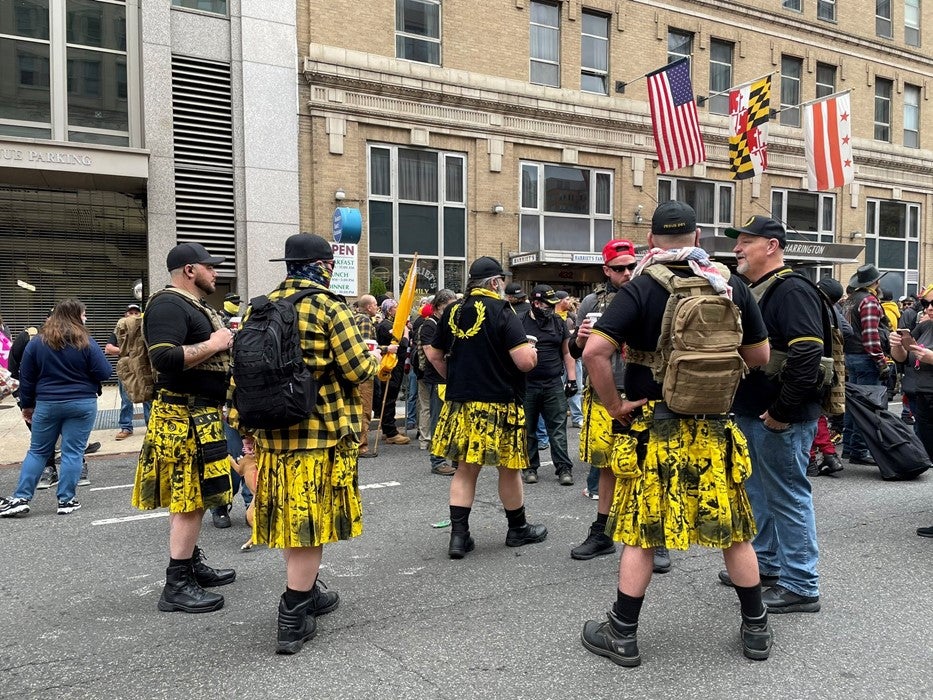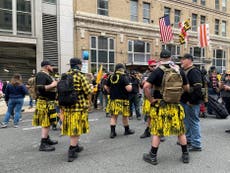The Proud Boys made yellow kilts the latest fashion victim of the far right. Here’s what we need to do now
The Proud Boys aren’t the first far-right group to appropriate a style to relay their membership. But what should we do when it happens?


In 2005, I was hankering for a yellow kilt. I searched far and wide for the perfect specimen, determined as a whippet in pursuit of a squirrel – but I never did find it. In the end, I had one made in a small kilt shop in Edinburgh a couple of years ago, perfect to my specifications and outrageously short.
Mine will be a familiar tale to many who grew up in the 90s, for whom an acid yellow mini-kilt was the single most coveted item – being as it was the signature look of the immaculately dressed Cher Horowitz, the Beverley Hills teenager played by Alicia Silverstone in Clueless.
Yet this week, the humble yellow kilt (albeit with a significantly longer hemline) hit the headlines in a very different way. In a strange turn of events, it has become the latest item of clothing to be adopted by the far-right, all-male, and notably anti-immigrant Proud Boys.
The self-proclaimed “Western chauvinists”, who were classified as an extremist group by the FBI in 2018, were photographed sporting the kilts at a pro-Trump rally this week, leading the designer to denounce them on Twitter and pull the yellow iteration of the item from sale.
The kilts in question feature punk-inspired leather patches, metal rivets and a black camo motif. They’re distinctly avant-garde, grunge and would not look out of place on a high-fashion catwalk – but the military connotations are clearly the thing that caused them to be snapped up by the far-right group. The Proud Boys sported them with camo backpacks, black army boots with black socks pulled up, black T-shirts and baseball caps with their chosen yellow laurel wreath symbol.
It’s a far cry from what the people who sold them the kilts expected. Allister Greenbrier, the LGBT+ designer behind the Virginia-based kilt brand Verillas, was horrified to see the group sporting his designs. He claimed that the group had described themselves as a metal band when they entered his store to purchase the garments. Greenbrier described the now-infamous photograph of the kilt-wearing right-wingers as a “nightmare scenario”, and the group as “the opposite of everything our brand stands for”. He donated the price of their purchases to the NAACP as an apparent fascist-offsetting.
One can only assume that the Proud Boys who chose such a uniform haven’t watched Clueless, or they likely wouldn’t have selected Cher as their latest fashion icon. In one of the film’s numerous quotable scenes, Cher famously stands up in front of her class in defiant support of immigration, saying, “May I please remind you that it does not say ‘RSVP’ on the Statue of Liberty?” Kilt-gate comes just two months after Fred Perry withdrew its black polo shirt with yellow trim from sale, after they also became the Proud Boys’ chosen garb for a time. “That association is something we must do our best to end,” the brand said in a statement.
The Proud Boys aren’t the first far-right group to appropriate a style to relay their membership. The Boogaloo Bois – a group intent on a second American Civil War – have adopted Hawaiian shirts; other far-right groups co-opted the logo of Detroit hockey team the Red Wings, pinning it to their jackets and emblazoning it on posters. Most famously, Dr Martens – a working boot that became a symbol of the British working class, then punk and skinheads – were embraced by neo-Nazis in the 1980s as part of their aggressive aesthetic. Worn with Levis, Harrington jackets, and braces over Fred Perry polo shirts, it became an unmistakable fascist uniform.
British sportswear label Lonsdale faced similar controversy when members of the far-right discovered that the letters NSDA – the letters in Hitler’s National Sozialistische Deutsche Arbeiter Partei (NSDAP) – were the only ones visible in their branded T-shirts when worn under jackets. A strong anti-racist marketing campaign by the brand shortly followed.
Uniforms, of course, visually unite groups, symbolising membership and shared ideology. So, what’s a designer to do when their creations are co-opted by people whose beliefs don’t align with their own? Removing the items from sale surely only serves to give them more power as inaccessible contraband.
Dr Martens managed to get by. The new generation of fans were too young to remember, and the boots are now so ubiquitous on the feet of the fashionable you can grab a pair in Topshop (though be quick …), with designers from Prada to Louboutin inspired to create their own versions. It’s fair to say that all associations with racist organisations are a thing of the past for DMs.
We are at a political turning point. The far-right is determined to make itself more palatable – and therefore popular – among young people and those who otherwise might not have involved themselves in an ideological cause at all. In doing so, they are rejecting the “extreme” shaved heads of the past and sartorially aligning themselves with liberal subcultures to entice members. Yellow kilts have, in recent years, been offered by the likes of Gucci – and Hawaiian shirts are as much seen on beach-loving dads as they are on right-wing anarchist Boogaloo Bois.
Designers can’t decree who can wear their looks: that much is obvious. They can only try and reclaim their symbols. And as consumers, the only way we can push back against this particular quirk of hate groups is to drown them out.
Perhaps it’s time to head on over to Verillas and buy out their kilts, diluting the message the Proud Boys so desperately wanted to send. It won’t solve the whole problem, but there’s no denying you can do serious damage to an organisation when you mess with its branding.



Join our commenting forum
Join thought-provoking conversations, follow other Independent readers and see their replies